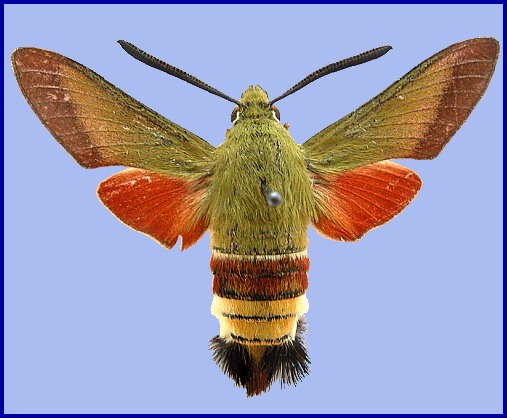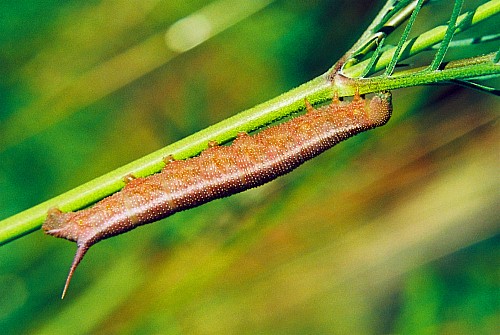UK: Olive Bee Hawkmoth, F: Macroglosse de Croatie, D: Olivegrüner Hummelschwärmer, RUS: Shmelevidka kroatskaja, CZ: Dlouhozobka korutanská, FIN: Kroatianpäiväkiitäjä, I: Sfinge croata, HR: hrvatska golupka.
Sphinx croatica Esper, 1800, Die Schmett. (Suppl.)(Abschnitt 2): 33, pl. 45, fig. 2.Type locality: Karlstadt [Karlovac, Croatia].
[Further details on this species, as well as photos of all stages, can be found on Lepiforum.]

Holarctic; western Palaearctic region. Pleistocene refuge: Polycentric -- Pontomediterranean and Iranian refugia.

Wingspan: 36--64mm. Easily distinguished from other western Palaearctic bee hawkmoths in that the wings remain fully scaled. Not a very variable moth. In some, the green is replaced by grey. In f. obscurata Closs, the forewing is dark, blackish green as are the two anterior segments of the abdomen, which has two very dark red belts. In f. rangowi Closs, the reddish brown submarginal bands of the forewing are very narrow, the hindwing small and pale with no dark margin, and the posterior abdominal segments are sulphur-yellow tipped with a velvet-black anal tuft with no red central mark. This latter form was found only in the steppe areas of Russia to the north-west of the Caspian Sea and appears to be now extinct (Zolotuhin, pers. comm.).
Care should be taken when identifying live individuals of this species in the field in southern Turkey as it has been confused several times in the past with Hemaris syra (Daniel, 1939). To confuse matters further, it also resembles Hemaris dentata (Staudinger, 1887).





Diurnal. Tends to follow hill and mountain chains, where it prefers open, hot, dry meadows interspersed with patches of woodland on mountain- and hillsides. Up to 2300m altitude in southern Iran (de Freine, 2004). In the chalk hills of the Saratov/Volgograd area, southern Russia, Hemaris croatica only frequents the hot south-facing slopes with good patches of Cephalaria (A. Zagorinsky, pers. comm. 2012). He collected 70 eggs over one hour, but did not find a single egg on the west- or east-facing slopes. In Jordan, a species of open oak forests (Müller et al., 2005a).





Usually univoltine across its northern range and at altitude, during July; bivoltine in its southern range, April/June and again in August/September, although Eversmann (1844) only recorded May/June for Sarepta on the lower Volga. In the southern Urals, early June (Nupponen & Fibiger, 2002). Efetov & Budashkin (1990) record three generations from the Crimea, in May/June, July/August and August/September. De Freine (2004) records late May for Kerman, Iran, at 2300m altitude.
OVUM: Almost spherical (1.1 x 1.0mm), pale glossy green. Laid singly on the underside of leaves of wild Scabiosa spp., with rarely more than one to a plant.

LARVA: Full-fed 45--50mm. Polymorphic.
On hatching, the 3mm-long larva is pale yellow with a dark horn.
Most full-grown larvae are primarily bright green and densely speckled with white spots. However, larvae are highly variable, with other colour forms ranging from yellowish white, through blue-green to pale red. All have the same pattern: dorsally a darker 'heart line' runs from head to horn, often bordered on either side by yellow, with a much more substantial white dorso-lateral line always present and blackish patches between the prolegs. Spiracles red, ringed with pale yellow; horn orange to reddish yellow to blue.

Throughout all instars, the larva exhibits the same feeding behaviour, resting along the midrib on the under-surface of a leaf, when not engaged in nibbling oval holes in it. Like Hemaris tityus (Linnaeus, 1758), it will usually fall to the ground if disturbed.
Double-brooded throughout most of its range, being found in June and July, and again during August and September; where only a single generation occurs, between July and September.




Major Hostplants. Scabiosa and Cephalaria spp. On Scabiosa argentea and Cephalaria coriacea in the Crimea (Efetov & Budashkin, 1990); along the Dalmatian Coast on Cephalaria leucantha.
Minor Hostplants. Asperula.
PUPA: 24--27mm. Reddish brown, tapering sharply towards the head. Proboscis prominent, almost keeled; head tubercles, or hooks, much more reduced than in the previous species. Formed in a loosely spun, light brown cocoon amongst ground debris. The overwintering stage.



None recorded.

From northern Italy (Lake Garda; Trieste) (Sala & Bettini, 2005) and southeastern Austria (Heinemann, 1859; Hoffmann & Klos, 1914) south-eastwards through the former Yugoslavia (Koren et al., 2011; Hanjalić & Lelo, 2015), Albania (Rebel & Zerny, 1932; Beshkov, Nahirnić-Beshkova & Jakšić, 2024), Republic of North Macedonia (Krpač et al., 2019), southern and eastern Bulgaria (Grosser, 1982; Ganev, 1984; Hristova & Beshkov, 2016), mainland Greece (Paul Cools, iNaturalist 2019), Turkey (Lederer, 1855; Daniel, 1932; de Freina, 1979; de Freina, 2012; Akin, 2012; Kemal & Koçak, 2014; Kemal & Koçak, 2016; Kemal & Koçak, 2017; Kemal & Koçak, 2018; Koçak & Kemal, 2018) to western Syria (M. Salimeh, iNaturalist 2024), the Lebanon (Zerny, 1933; Ellison & Wiltshire, 1939), western Jordan (Müller et al., 2005a), Mount Hermon and the Golan in northern Israel (Müller et al., 2005b), northern Iraq (Kemal & Koçak, 2018c), the Crimea and eastern Ukraine (Efetov & Budashkin, 1990; Budashkin & Rayevsky, 1997; Sergey D., iNaturalist 2009), neighbouring Russia - near Rostov (Poltavsky & Stradomsky, 2004) and the Russian Caucasus/Daghestan area (Abdurahmanov, 1999; Alexey Katz, iNaturalist 2021), the Republic of Georgia (Didmanidze, Petrov & Zolotuhin, 2013; Natalia Bulbulashvili, iNaturalist 2023), Armenia (Karagyan, Kalashian, Ghrejyan & Danchenko, 2019), Azerbaijan (Snegovaya & Petrov, 2021), then southwards along the Iranian plateau to Shiraz (Pittaway, 1993) and Kerman (Danner, Eitschberger & Surholt, 1998; de Freina, 2004).
In April 2016 a nectaring adult was photographed at Alkanna orientalis in the Jebel al Lawz of northwestern Saudi Arabia (Francis Gilbert, pers. obs. 2016).
In July 2022 a nectaring adult was photographed at Lavandula near Milatos Beach in northern Crete (Tristan Ostrowski, iNaturalist 2022). As this is the first time this species has been recorded from this island, the individual in question was probably a vagrant.
In Croatia, generally confined to the Mediterranean coastal areas and closely tied to the distribution of its main hostplant, namely species of Cephalaria (Habeler, 2003; Koren et al, 2011; Koren & aić, 2023)
Locations for Bulgaria are: Kresna Gorge (Blagoevgrad, 660m); Rozhen (Grosser, 1982); Sandanski; Svilengrad; Kazanluk; Sliven; Varna.
A single individual has been reported from Romania, by A. Caradja, but König (2003) thinks this obsevation may be unreliable.
Contrary to what has been published, this species has never been found in present-day Hungary. The locality given by Abafi-Aigner et al. (1896), namely Károlyváros, refers to the type locality, Karlovac. At that time this was in the old Kingdom of Hungary (Szabolcs Safian, pers. comm. 2005). Kovacs (1953), quite rightly, does not list this species for modern-day Hungary.
Freyer (1836) relates that he received a larva of this species from Kindermann, who was then living in Switzerland but there is no mention of where it was found. This specimen may possibly have given rise to the rumour that Hemaris croatica was resident in Switzerland. In the same work, Freyer recorded that this species was to be found in small numbers in the neighbourhood of Salzburg, Austria, and Heinemann (1859) also recorded this species from the province of Kärnten, Austria, where it is now extinct. In view of the extinction in Switzerland this century of the equally thermophilic papilionid Zerynthia polyxena ([Denis & Schiffermüller], 1775) (Schweizerischer Bund für Naturschutz, 1987) and its virtual disappearance from Austria, Hemaris croatica probably occurred at one time in a few favourable locations farther north than the present-day limit of its range, which is the south-east corner of Austria (Pittaway, 1993) and Monte Baldo, Lake Garda, Italy (Nardi & Spada, 2013). However, there were several sightings of this species from Switzerland in 1962 (Schweizerischer Bund für Naturschutz, 1997) which require further study.
A similar series of extinctions of relict populations has also taken place in Russia over the last 100 years. At the end of the last century Hemaris croatica occurred north along the Volga river valley (Russia), from Sarepta (near Volgograd) to Kazan (Eversmann, 1844), with it being very rare at Kazan. Zolotuhin (pers. comm.) uncovered a specimen from Uralsk (Ural river, Kazakhstan) in the Soviet national collections from the early part of this century, and Closs (1917) described f. rangowi from the Kalmyk A.S.S.R. Most of these populations appear to be now extinct, although Nupponen & Fibiger (2002) did recently discover a small population south of the Ural Mountains on the Kazakhstan border around Kuvandyk, Orenburg Oblast (Shovkoon, 2011), and this species has been rediscovered in the chalk hills running between Volgograd and Saratov (Chuvilin, 2005). However, Hemaris croatica has not been recorded from the Kopet-Dagh of Turkmenistan for some time.
Records from the Republic of Georgia are mostly from old collections. It has now become extremely local in this country (Didmanidze, Petrov & Zolotuhin, 2013).
Similarly, the record by Nardi & Spada (2013) of a single specimen from the Monte Baldo area east of Lake Garda, northern Italy (vii.1968, Ulrich leg.), may indicate either a relict population or, more likely, that this species may be recolonizing northern Italy as the climate warms.
Extra-limital range. None.

Lorestan\Luristan Province, Western Iran, as Hemaris croatica fahira De Freina, 2004.
 Return to species list
Return to species list